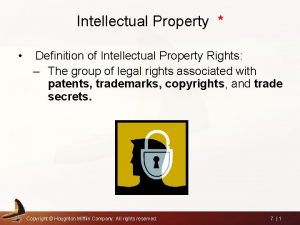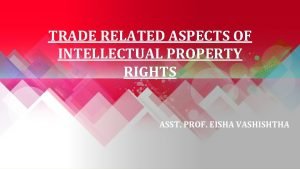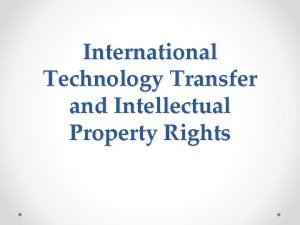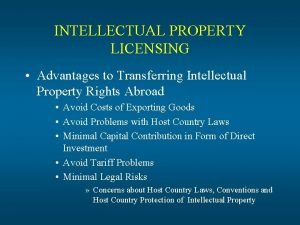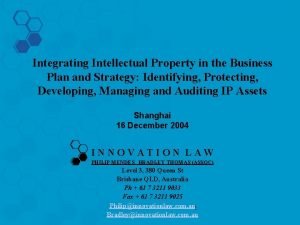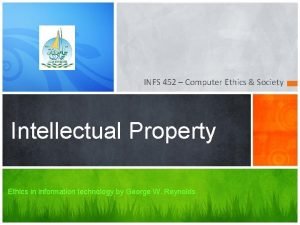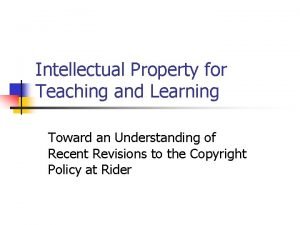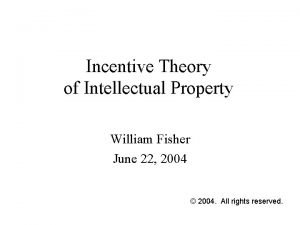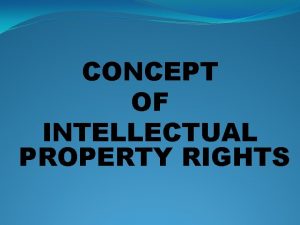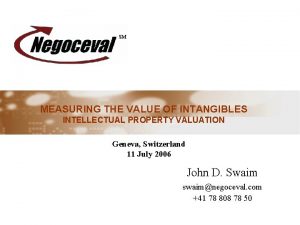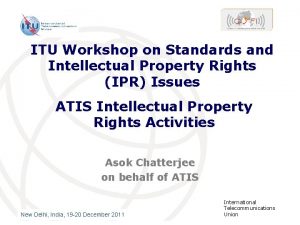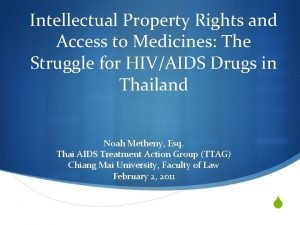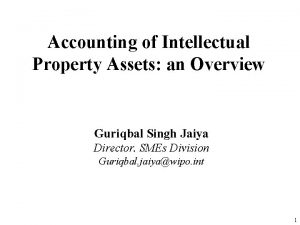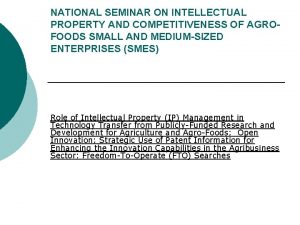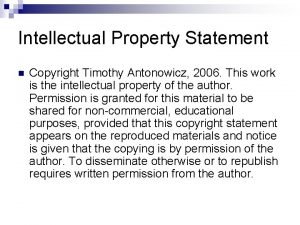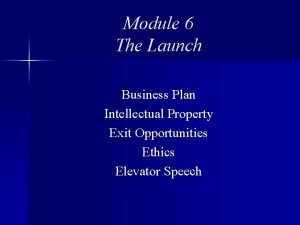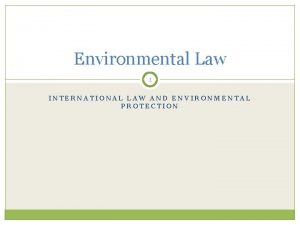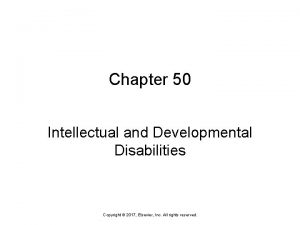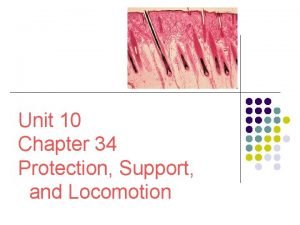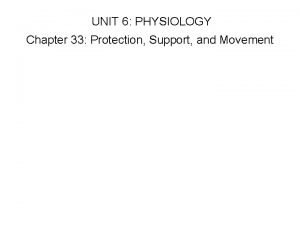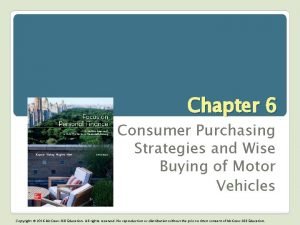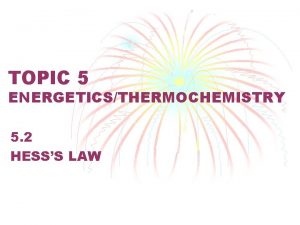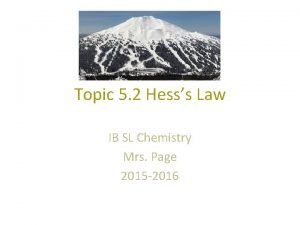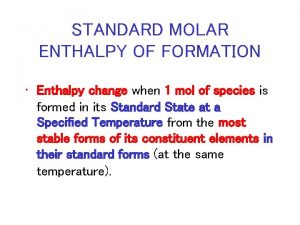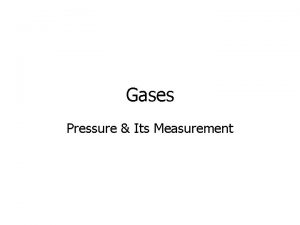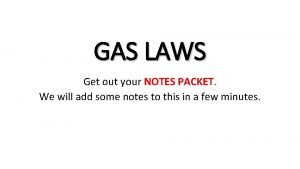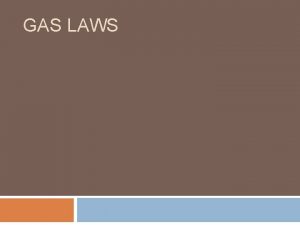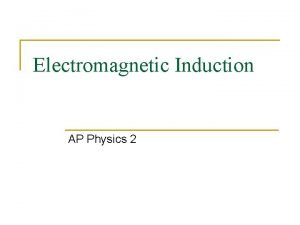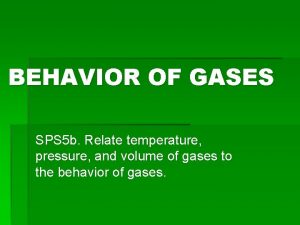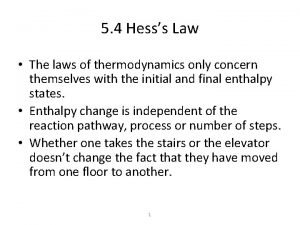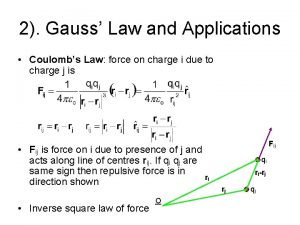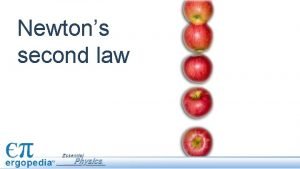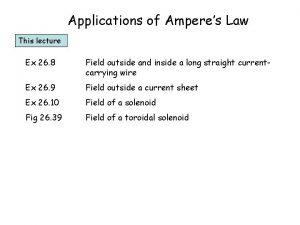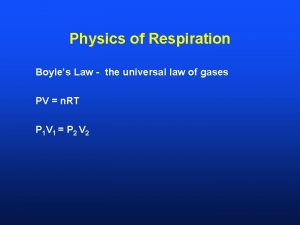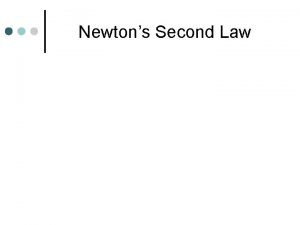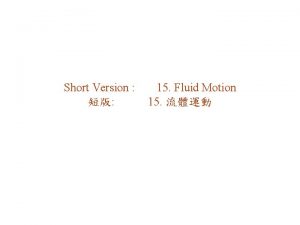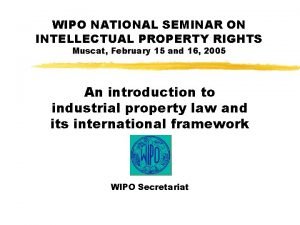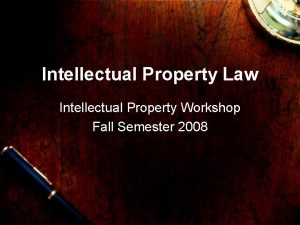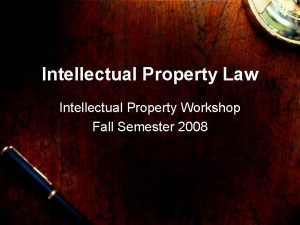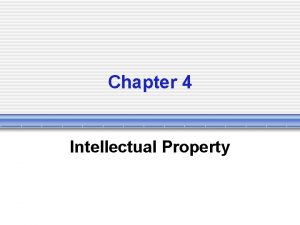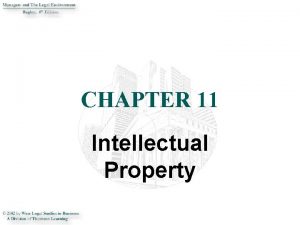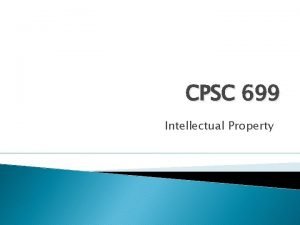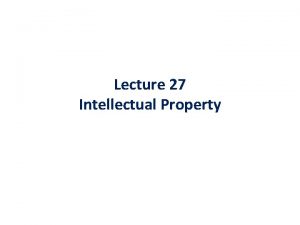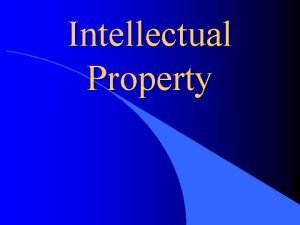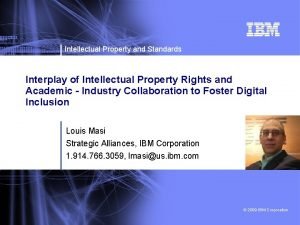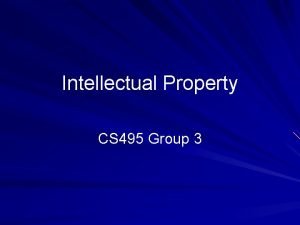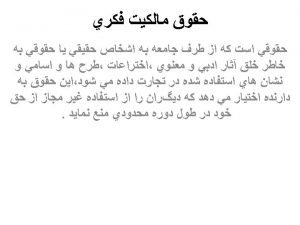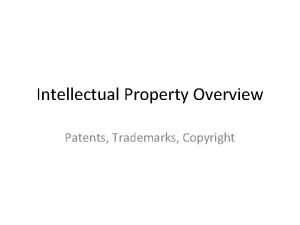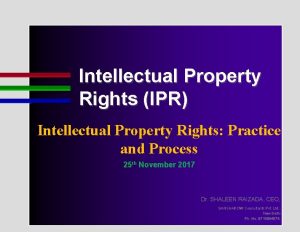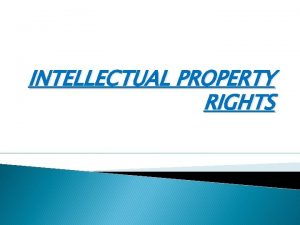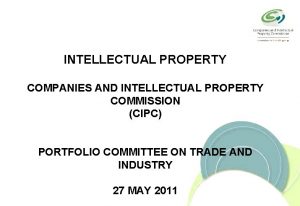Property Law Chapter 5 Intellectual Property Application Protection




















































- Slides: 52

Property Law Chapter 5 Intellectual Property – Application, Protection and Commercial Value www. learnnowbiz. com Property Law

1. 1 Introduction DEFINITION – Intellectual property refers to the property that is a product of one’s mind. It is a legal right to intangible property that cannot be occupied like real property or possessed in the same manner as other items of personal property. Intellectual property rights extend protection to the creative and commercial interests resulting from a creation by an individual, or the monopoly rights which a person acquires over the use of a ‘product’ which has been brought into existence by original creative effort. www. learnnowbiz. com Property Law

Introduction • The rights held by the creators exist for various time periods depending on the nature of the interest protected. • The rights in intellectual property are protected to encourage creative intellectual endeavours, and to prevent other people from benefiting from someone else’s labour. • For many businesses, intellectual property is their most valuable asset. • - The main forms of intellectual property are: Copyright Patents Designs Trade marks www. learnnowbiz. com Property Law

Introduction • Trademarks form part of the visual landscape of our lives and inform our purchasing decisions. • The threat of copyright infringement tries (and some may say fails) to protect the illegal downloading of music and films from internet sources but copyright also applies to protect commercial documents such as business plans, advices, marketing plans and data bases. • Design registration which protects the visual appearance of a product could be applicable to the shape of the lettuce crisper in your kitchen, the pattern on your plate or the tread on the tyre of your car. www. learnnowbiz. com Property Law

Introduction • The creator of intellectual property is not always the automatic owner of the rights to that property. • Intellectual property with the exception of copyright and circuit layout rights must be registered to obtain legal rights of ownership. If registration does not occur, the party asserting ownership may still be able to prove ownership in court, but it will be much more difficult. www. learnnowbiz. com Property Law

Introduction • If registration of intellectual property rights is required to protect the interest in Australia, the interest will not necessarily be protected internationally. • Generally, registration must occur in every jurisdiction in which a party asserts ownership. • The requirement may vary, however, based on the right being sought. • The government body responsible for administering intellectual property in Australia other than copyright is IP Australia. VISIT WEBSITE AT: - http: //www/ipaustralian. gov. au/ www. learnnowbiz. com Property Law

Introduction www. learnnowbiz. com Property Law

5. 2 Copyright does not protect ideas. Instead, it provides a protective mechanism for the expression of ideas and original material such as: • music • films • plays • novels • artworks • computer programs, • scripts and much more … others ? ? www. learnnowbiz. com Property Law

Copyright • Copyright is governed by the Copyright Act 1968 (Clth) and prevents unauthorised reproduction of works by a third party. Works do not have to be registered to receive the protection of copyright – this right comes into existence as soon as the material subsists. • Material that is protected by copyright is also entitled to protection in other countries that are signatories to the relevant international treaties of which Australia is a member through the process of national treatment. www. learnnowbiz. com Property Law

Copyright Original Works Under Part III of the Act, copyright protection is available for the following Original Works: 1. Literary work – any work expressed in writing eg: - novel, poem, computer program 2. Dramatic work – any work recorded in material form which is intended and able to be performed or represented in some way eg: - film , television show 3. Musical work – any work which is intended and able to be performed as a piece of music includes musical score, musical lyrics and musical arrangements 4. Artistic work – any work, in some physical form, which is created as a piece of artistic expression. This includes a drawing, painting, sculpture and a photo. www. learnnowbiz. com Property Law

Copyright The Rights of Copyright Holders Only the owner of the copyright can deal with the work and allow others to do so. This means that rights of copyright owners are exclusive rights. www. learnnowbiz. com Property Law

Copyright Original Works The creator of Original Work is presumed to be the owner of the copyright. There are exceptions to this presumption, however, which include: • When the work has been commissioned and paid for by someone else, the ownership of the copyright will usually rest with the person who has commissioned the work. • When the work has been carried out in the course of employment • When agreements have been made as to joint ownership. • When agreements have been made to assign ownership to another. www. learnnowbiz. com Property Law

Copyright Assigning and Licensing The Act also permits the owner’s exclusive rights to be assigned and licensed to others to use the works. An assignment is a transfer of the ownership of the copyright and must be in writing. A license permits the licensee to deal in the copyright subject matter for certain purposes and may also be implied. www. learnnowbiz. com Property Law

Copyright Subsistence Copyright subsists (i. e. comes into existence) when a work is first published or made available to the public. When a work is not published, copyright subsists when first reduced to a material form such as writing. Material is protected by copyright from the instant it is written in words, filmed, painted, etc. Original Works For copyright to subsist in Original Works, however, a number of further requirements under the Act must be met: 1. The works must be original 2. The works must be in a material form 3. The works must be of a literary, dramatic, musical or artistic nature. 4. There must be some connection with the work to Australia. www. learnnowbiz. com Property Law

Copyright Duration The duration of copyright depends on its type and whether it is published during the life of the author. www. learnnowbiz. com Property Law

Copyright Infringement • Copyright is infringed when someone uses all, or a “substantial part” of the copyright protected work of another without their authorisation or consent where no defence or exception to infringement applies. • Whether an owner ‘authorised’ an act is determined by looking at matters such as whether any reasonable steps were taken to avoid any infringing act and the extent of the person’s power to prevent the infringing act. www. learnnowbiz. com Property Law

Copyright • Under the Act, a person cannot sell materials (or offer them for other commercial purposes) if they knew, or ought to have known, that the materials were infringing another’s copyright. • Further, a person who imports materials for commercial purposes in Australia is also in breach of the Act, if they knew (or ought to have known) that the material would, if created in Australia, be infringing on another’s copyright. www. learnnowbiz. com Property Law

Copyright A person who permits the performance of copyright-infringing material in a place of public entertainment may be guilty of infringing copyright unless: - • The person was not aware, and had no reasonable grounds for suspecting, that the performance would infringe copyright; or • The permission to use the place of entertainment was provided free of charge, or with charges only sufficient to cover reasonable expenses. www. learnnowbiz. com Property Law

Copyright Actions not amounting to infringement 1. 2. 3. 4. 5. 6. 7. 8. 9. Research or study. Criticism or review. Parody or satire. Reporting of the news. Legal proceedings or professional advice by a legal practitioner. Using insubstantial parts. Public readings. Performance in or at residential premises. Multiple copies of minor portions of works for educational purposes in schools and other educational institutions. 10. Filming or recording broadcasts or films for private use. 11. . The drawing, painting or photograph of an artistic work or building in a public place, or the inclusion of the work in a film or television broadcast. www. learnnowbiz. com Property Law

Copyright Remedies for Infringement The Copyright Act allows the following remedies to the owner on infringement of copyright: - 1. 2. 3. 4. 5. 6. 7. Injunction Damages Additional damages Account of profit Damages for conversion or detention Delivery of infringing material Anton Pillar (search premises) www. learnnowbiz. com Property Law

Copyright Protecting copyright in the commercial environment • The Copyright Act does not require publication, registration or the payment of fees in order to provide copyright protection in Australia or in any other country which is also a party to an international copyright treaty. • Copyright protection is granted automatically from the time an original work is created. • It is sensible practice to clearly assert copyright by always including the copyright symbol ©, name and date on the work. • Owners may place a copyright notice in a prominent place on their work. www. learnnowbiz. com Property Law

Copyright Protecting copyright in the commercial environment • Confidentiality agreements may be adopted when an owner is disclosing copyright material involving trade secrets, confidential information or expertise – in any situation where the owner is disclosing information that must remain confidential. • Copyright owners should regard their copyright as an item of property and consequently deal with it in a commercially sensible and defensive manner. • Dated copies of the work should always be kept together with letters submitting work to others. • Do not sign documents dealing with copyright without fully understanding their consequences. www. learnnowbiz. com Property Law

5. 3 Ownership The creator of Original Work is presumed to be the owner of the copyright. There are exceptions to this presumption, however, which include: • When the work has been commissioned and paid for by someone else, the ownership of the copyright will usually rest with the person who has commissioned the work, although there are exceptions. • When the work has been carried out in the course of employment. For example, if an employee in the food industry produces a report for the company on the state of the food industry, the copyright in such a report is owned by the employee’s company and not the employee. Note that employed journalists own the copyright to works produced by them for some purposes. • When agreements have been made as to joint ownership. • When agreements have been made to assign ownership to another www. learnnowbiz. com Property Law

5. 4 Other Rights under the Copyright Act 1968 (Cth) The Act also provides: 1. Moral Rights - are personal rights belonging to the original individual creators and cannot be transferred, assigned, sold or left by will. 2. Performers’ Rights - rights in the sound recording of a live performance by them and rights in relation to the reproduction or communication of a live performance. www. learnnowbiz. com Property Law

5. 5 Designs • The Designs Act 2003 (Clth) provides a system for the registration and protection of designs. • Section 5 of the Act states that a design means the overall appearance of a product resulting from one or more of its visual features – for example, the design of a unique folding chair or a water-bottle label. www. learnnowbiz. com Property Law

Designs • Design is concerned with the visual form of an article rather than its manner of construction. • It relates to a product’s features of shape, configuration, pattern or ornamentation which gives it a unique appearance. • A design that is registered gives the owner protection only for the visual appearance of the product, www. learnnowbiz. com Property Law

Designs • A design that is registered gives the owner protection only for the visual appearance of the product, and not for how the product works. Once a product is registered however, the registered owner gains the rights to use, license and sell the design. People who may be registered as the owners of designs include: - • The person who created the design. • An employer if the design was created during the course of employment. A person who has contracted with a designer to create a design. • A person who inherits ownership through a will. www. learnnowbiz. com Property Law

Designs Registration • In order for a design to be registered, the design must be new and distinctive. A design is new if it has not been publicly used in Australia or published in a document within or outside Australia. • A design is distinctive if it is not substantially similar in overall impression to other designs already in the public domain. • A design application must be accompanied by a representation or illustration of the design, for example, a photograph, a drawing or digital images. • Registration protects a design for five years from the date the application is filed. The protection period can then be renewed for a further five years. www. learnnowbiz. com Property Law

Designs Infringement and Remedies • A design will be infringed if a design is created or used without authority or a licence that is substantially similar in overall impression to the registered design. • Unlike infringement of copyright, the design owner needs to prove only that the defendant produced an article similar or identical to the registered design. • The Act does provide a potential exclusion: when a registered design is used in a repair context to repair the appearance of a complex product, this may not amount to an infringement of the design. www. learnnowbiz. com Property Law

Designs Infringement and Remedies • The owner of a registered design will only be able to enforce their rights against an infringement of their design is certified following an examination. • If their design is certified, the registered owner will be able to seek relief in the form of an injunction, damages or an account of profits. • A plaintiff has to elect between damages and an account of profits as both cannot be sought. • The Court may refuse to award relief if it finds the defendant was not aware that the design was registered. www. learnnowbiz. com Property Law

5. 6 Patents DEFINITION - A patent is a right granted in relation to any device, substance, method or process which is new, inventive and useful. • The Patents Act 1990 (Cth) provides a grant to the inventor for the sole and exclusive right to exploit, and authorise others to exploit, the invention. • Exclusive rights include the ability to reproduce the invention, sell it, licence it and allow others to do the same. • The exclusive rights are personal property and are capable of assignment and of devolution by law. • The owner of the patent is generally the inventor. www. learnnowbiz. com Property Law

Patents • A patent is effectively an incentive to invent. In return for the exclusive rights to exploit the patent granted by the Crown, patent owners must share their innovation by providing a full description of the operation of the invention. • This knowledge then becomes public and provides a basis on which further research may be conducted by others. www. learnnowbiz. com Property Law

Patents Types of patents 1. Standard patent 2. Innovation patent ADVANTAGE – Cheaper, quicker, does not require approval from the Commissioner of Patents DISADVANTAGE – Cannot be enforced or defended in court until after the process of examination has taken place and it is determined that it meets the relevant requirements of the Patent Act and certification is awarded. www. learnnowbiz. com Property Law

Patents Who can apply? The following persons can apply for a patent: - 1. 2. 3. 4. The inventor The assignee of the inventor The person deriving title from the inventor or inventor’s assignee The employer of an employee who invents something in the normal course of their employment. www. learnnowbiz. com Property Law

Patents Registration and Approval Four conditions must be met before a standard patent is registered or an innovation patent is approved: - 1. It must be in a recognised category of subject matter. 2. It must contain a new manner of manufacture - the applicant must create a new way in which the idea can operate. 3. It must be novel- It cannot have been published before or been used before 4. It must be useful- It must do what it is claimed to do, be capable of replication and be of practical utility. www. learnnowbiz. com Property Law

Patents Remedies A patent will be infringed if an unauthorised person reproduces the invention or sells or makes use of the invention for commercial purposes. On the infringement of a patent, the owner can seek the following remedies: - 1. 2. 3. 4. Injunction Damages Additional damages An account of profits These remedies may not be available if the defendant was not aware and had no reason to believe that a patent for the invention existed. www. learnnowbiz. com Property Law

Patents Revocation A patent can be cancelled if the invention fails to satisfy one of the requirements or was obtained by fraud, false information or misrepresentation. Business rivals of the inventor are often the applicants for revocation. www. learnnowbiz. com Property Law

5. 7 Trade Marks DEFINITION - A trade mark is a mark that can be used by providers to distinguish their goods and services. The Trade Marks Act 1995 (Clth) regulates trade marks. EXAMPLES - words, letters, phrases, numbers, logos, smells, shapes, pictures, an aspect of packaging and brand names, or even a combination of all of those. www. learnnowbiz. com Property Law

Trade Marks • The Act allows for the registration of trade marks. • A registered owner of a trade mark has the exclusive right to use, license or sell the trade mark within Australia for the goods and services to which the mark is registered, as well as authorise other persons to use the trade mark in that manner. www. learnnowbiz. com Property Law

Trade Marks For a trade mark to be considered for registration, the following elements must be present: - 1. 2. 3. 4. There must be a sign (e. g. words, letters, logo); The trade mark must be used or intended to be used; The trade mark must distinguish goods or services; and The trade mark must be dealt with or provided in the course of trade. www. learnnowbiz. com Property Law

Trade Marks Registration • To gain registration of a trade mark, an applicant must apply to IP Australia, where a register of trade marks is kept. • An undivided register of trade marks is kept at IP Australia. • Applicants apply for registration in relation to a class of goods or services such as pharmaceuticals, musical instruments, furniture, household utensils, telecommunications, or medical services. www. learnnowbiz. com Property Law

Trade Marks Registration The Registrar must examine and report on whether the application is made in accordance with the Act and whethere any grounds for rejecting it. A trade mark may be refused registration because: - • • It is not sufficiently different from other marks. It will not distinguish the goods and services from the goods and services of other persons. It contains prohibited signs. It cannot be represented graphically. It contains scandalous material or its use would be contrary to law. It is likely to cause deceit or confusion or mislead the public about the nature of the goods or services. It contains common surnames or geographical names. www. learnnowbiz. com Property Law

Trade Marks Registration • Registration runs for a period of ten years and may be renewed indefinitely. • Applications for trade marks, however, can be opposed. This may be carried out by a competitor or a party who has been using a similar mark. www. learnnowbiz. com Property Law

Trade Marks Infringement • A person will infringe a registered trade mark if they use as a trade mark a sign that is substantially identical with, or deceptively similar to, another trade mark that relates to similar goods or services. • A person will not have infringed the trade mark, however, if they establish that the sign is not likely to deceive or cause confusion. www. learnnowbiz. com Property Law

Trade Marks Remedies On the infringement of a trade mark, the owner may seek an : - 1. Injunction 2. Commence an action for either damages 3. A account of profits. www. learnnowbiz. com Property Law

5. 8 Domain Names Domain names are a form of identity that a business or individual can use. They are no a form of statutory intellectual property. Internet Corporation for Assigned Names and Numbers The Internet Corporation for Assigned Names and Numbers (ICANN) is the international non-profit organisation responsible for Domain Names system management. Furthermore, ICANN has a role to play in settling disputes under the Uniform Domain Name Dispute Resolution Policy. www. learnnowbiz. com Property Law

5. 9 Passing Off • The tort of passing off may be used instead of an action for breach of trade mark. • This tort protects a trader’s rights in the goodwill they have built up regarding their products and/or business. • The tort occurs when a person makes a representation that falsely suggests some connection to another person’s products and/or business. www. learnnowbiz. com Property Law

Passing Off The tort of passing off applies where there is a representation that a person’s goods or services are those of someone else. Process To establish passing off, the plaintiff must prove a misrepresentation made by a trader in the course of trade to prospective customers or consumers that is intended to injure the plaintiff's business or goodwill and that caused actual damage to the plaintiff. www. learnnowbiz. com Property Law

5. 10 Breach of Confidential Information • As seen earlier, intellectual property protects the physical expression of an idea, not the idea itself. • Courts have approved of an action to protect ideas alone, regardless of whether they exist in any material form. This action is breach of confidential information (or breach of confidence), which may be considered an implied condition of a contract. www. learnnowbiz. com Property Law

Breach of Confidential Information What information is confidential? Confidential information may be categorised as: - 1. Commercial information: this has not been specifically defined by the courts but may include any information having a commercial value including trade secrets, drawings, plans, processes, recipes, survey results, sales profiles, lists of customers, price lists. 2. Personal or government information: this is information with no commercial value, but the disclosure of which could cause distress www. learnnowbiz. com Property Law

Breach of Confidential Information The elements of confidential information The following elements are required to establish breach of confidence: 1. The information itself must necessitate confidence 2. The information must have been given to the defendant in circumstances which imply an obligation of confidence: 3. Disclosure to a third party www. learnnowbiz. com Property Law

Breach of Confidential Information Remedies for breach of confidential information may include action for breach of contract, damages or injunction. www. learnnowbiz. com Property Law
 Definition of ipr
Definition of ipr Trade related aspects of intellectual property rights
Trade related aspects of intellectual property rights Intellectual property in professional practices
Intellectual property in professional practices Importance of intellectual property
Importance of intellectual property Intellectual property management definition
Intellectual property management definition Advantages of intellectual property
Advantages of intellectual property Intellectual property business plan
Intellectual property business plan Intellectual property in computer ethics
Intellectual property in computer ethics Right to intellectual property of teachers
Right to intellectual property of teachers Incentive theory
Incentive theory Concept of intellectual property
Concept of intellectual property Valuation of ip
Valuation of ip Intellectual property rights
Intellectual property rights Intellectual property rights
Intellectual property rights Characteristics of intellectual property
Characteristics of intellectual property Discuss intellectual property frankly
Discuss intellectual property frankly Intangible inputs
Intangible inputs Intellectual property
Intellectual property Intellectual property statement
Intellectual property statement Intellectual property business plan example
Intellectual property business plan example Evalueserve patent search
Evalueserve patent search Discuss intellectual property frankly
Discuss intellectual property frankly At&t intellectual property
At&t intellectual property Newton's first law and second law and third law
Newton's first law and second law and third law Newton's first law
Newton's first law Boyle's law charles law avogadro's law
Boyle's law charles law avogadro's law How to calculate boyle's law
How to calculate boyle's law Law on environmental protection
Law on environmental protection Chapter 9 intellectual development of infants
Chapter 9 intellectual development of infants Chapter 50 intellectual and developmental disabilities
Chapter 50 intellectual and developmental disabilities Commutative property vs associative property
Commutative property vs associative property Classification of property law
Classification of property law Physical properties of ice cube
Physical properties of ice cube Chapter 34 protection support and locomotion
Chapter 34 protection support and locomotion Chapter 33: protection, support, and movement answers
Chapter 33: protection, support, and movement answers Chapter 6 consumer purchasing and protection
Chapter 6 consumer purchasing and protection Define standard enthalpy of formation,δhf⁰
Define standard enthalpy of formation,δhf⁰ Application of hess law
Application of hess law Standard molar enthalpy of formation equation
Standard molar enthalpy of formation equation Applications of boyle's law
Applications of boyle's law Real life example of boyle's law
Real life example of boyle's law Charles law in real life examples
Charles law in real life examples Application of faraday's law
Application of faraday's law Charles's law application in real life
Charles's law application in real life Application of hess law
Application of hess law Gauss law to coulomb's law
Gauss law to coulomb's law 2nd law of motion
2nd law of motion Ampere's law for solenoid
Ampere's law for solenoid Application of boyle's law
Application of boyle's law Newton's second law of motion examples
Newton's second law of motion examples Fluid 15
Fluid 15 Obstructed heritage and unobstructed heritage
Obstructed heritage and unobstructed heritage Property law
Property law
